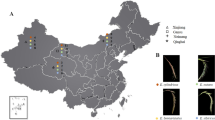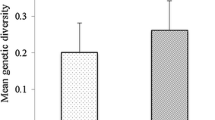Abstract
Switchgrass (Panicum virgatum L.) is a warm season, C4 perennial grass native to most of North America with numerous applications, including use as a bioenergy feedstock species. To date, no studies on genetic diversity in switchgrass have been conducted that use both molecular and morphological markers. The objectives of this study were to assess genetic diversity and determine differences among and between 12 switchgrass populations grown in New Jersey by examining both morphological and molecular characteristics, and to determine whether morphological, molecular, and/or combined data sets can detect ecotype and/or geographical differences at the population level. Twelve plants from each population were characterized with 16 switchgrass expressed sequence tag-simple sequence repeat markers (EST-SSRs) and seven morphological characters. Data was analyzed using GenAlEx and Unweighted Pair-Group Method of Averages (UPGMA) cluster analysis. Most (64%) of the molecular variation in switchgrass populations exists among individuals within populations, with lesser amounts between populations (36%). Upland and lowland populations were distinguished in all three data sets. Some eastern US and midwestern US populations were distinct in all three data sets. Similarities were observed between all three data sets indicating molecular markers may be useful for identifying morphological differences or other adaptive traits. The combined data set was the most useful in differentiating populations based on geography and found separation between midwestern and eastern upland populations. The results indicate that the combination of morphological and molecular markers may be useful in future applications such as genetic diversity studies, plant variety protection, cultivar identification, and/or identifying geographic origin.



Similar content being viewed by others
Abbreviations
- AFLP:
-
Amplified fragment length polymorphism
- AMOVA:
-
Analysis of molecular variance
- EST-SSR:
-
Expressed sequence tag-simple sequence repeats
- PCA:
-
Principal component analysis
- RAPD:
-
Random amplified polymorphic DNA
- RFLP:
-
Restriction fragment length polymorphism
- UPGMA:
-
Unweighted pair-group method of averages
References
Boe A, Ross JG (1998) Registration of ‘Sunburst’ switchgrass. Crop Sci 38:540
Budak H, Shearman RC, Parmakasiz I, Gaussoin RE, Riordan TP, Dweikat I (2004) Molecular characterization of Buffalograss germplasm using sequence-related amplified polymorphism markers. Theor Appl Genet 108:328–334
Casler MD (2005) Ecotypic variation among switchgrass populations from the Northern USA. Crop Sci 45:388–398
Casler MD, Stendal CA, Kapich L, Vogel KP (2007) Genetic diversity, plant adaptation regions, and gene pools for switchgrass. Crop Sci 47:2261–2273
Casler MD, Vogel KP, Taliaferro CM, Ehlke NJ, Berdahl JD, Brummer EC et al (2007) Latitudinal and longitudinal adaptation of switchgrass populations. Crop Sci 47:2249–2260
Chistiakov DA, Hellemans B, Volckaert FAM (2006) Microsatellites and their genomic distribution, evolution, function, and applications: a review with special reference to fish genetics. Aquaculture 255:1–29
Das MK, Fuentes RG, Taliaferro CM (2004) Genetic variability and trait relationships in switchgrass. Crop Sci 44:443–448
Duran LA, Blair MW, Giraldo MC, Macchiavelli R, Prophete E, Nin JC et al (2005) Morphological and molecular characterization of common bean landraces and cultivars from the Caribbean. Crop Sci 45:1320–1328
Excoffier L, Smouse PE, Quattro JM (1992) Analysis of molecular variance inferred from metric distances among DNA haplotypes: application to human mitochondrial DNA restriction data. Genetics 131:479–491
Ferguson ME, Bramel PJ, Chandra S (2004) Gene diversity among botanical varieties in peanut (Arachis hypogaea L.). Crop Sci 44:1847–1854
Ferriol M, Pico B, Nuez F (2003) Genetic diversity of a germplasm collection of Cucurbita pepo using SRAP and AFLP markers. Theor Appl Genet 107:271–282
Franco J, Crossa J, Ribaut JM, Betran J, Warburton ML, Khairallah M (2001) A method for combining molecular markers and phenotypic attributes for classifying plant genotypes. Theor Appl Genet 103:944–952
Freckmann RW, Lelongfford MG (1993) Panicum. In: Flora of North America Editorial Committee (eds) Magnoliophyta:Commelinidae (in part):Poaceae, part 2. Flora of North America North of Mexico, vol 25. New York and Oxford, pp 450–488
Garcia AAF, Benchimol LL, Barbosa AMM, Geraldi IO, Souza CL, de Souza AP (2004) Comparison of RAPD, RFLP, AFLP, and SSR markers for diversity studies in tropical maize inbred lines. Genet Mol Biol 27:579–588
Gomez OJ, Blair MW, Frankow-Lindberg BE, Gullberg U (2004) Molecular and phenotypic diversity of common bean landraces from Nicaragua. Crop Sci 44:1412–1418
Gunter LE, Tuskan GA, Wullschleger SD (1996) Diversity among populations of switchgrass based on RAPD markers. Crop Sci 36:1017–1022
Hein MA (1958) Registration of Caddo switchgrass. Agron J 50:399
Hopkins AA, Taliaferro CM, Murphy CD, Christian D (1996) Chromosome number and nuclear DNA content of several switchgrass populations. Crop Sci 36:1192–1195
Huff DR, Peakall R, Smouse PE (1993) RAPD variation within and among natural populations of outcrossing buffalograss (Buchloe dactyloides (Nutt.) Englem). Theor Appl Genet 86:927–934
Hultquist SJ, Vogel KP, Lee DJ, Arumuganathan K, Kaeppler S (1996) Chloroplast DNA and nuclear DNA content variations among cultivars of switchgrass, Panicum virgatum L. Crop Sci 36:1049–1052
Hultquist SJ, Vogel KP, Lee DJ, Arumuganathan K, Kaeppler S (1997) DNA content and chloroplast DNA polymorphisms among switchgrasses from remnant midwestern prairies. Crop Sci 37:595–598
Kothera L, Richards CM, Carney SE (2007) Genetic diversity and structure in the rare Colorado endemic plant Physaria bellii Mulligan (Brassicaceae). Conserv Genet 8:1043–1050
Kubik C, Sawkins M, Meyer WA, Gaut BS (2001) Genetic diversity in seven perennial ryegrass (Lolium perenne L.) cultivars based on SSR markers. Crop Sci 41:1565–1572
Kubik C, Honig JA, Meyer WA, Bonos SA (2009) Genetic diversity of creeping bentgrass cultivars using SSR markers. Int Turfgrass Soc Res J 11:533–547
Kumar LS (1999) DNA markers in plant improvement: an overview. Biotechnol Adv 17:143–182
Lewandowski I, Scurlock JMO, Lindvall E, Christou M (2003) The development and current status of perennial rhizomatous grasses as energy crops in the US and Europe. Biomass and Bioenerg 25:335–361
Li Y, Korol AB, Fazima T, Nevo E (2004) Microsatellites within genes: structure, function, and evolution. Mol Biol Evol 21:991–1007
Lu K, Kaeppler SW, Vogel K, Arumuganathan K, Lee DJ (1998) Nuclear DNA content and chromosome numbers in switchgrass. Gt Plains Res 8:269–280
Marvaldi AE, Sequeira AS, O’Brien CW, Farrell BD (2002) Molecular and morphological phylogenetics of Weevils (Coleoptera, Curculionoidea): do niche shifts accompany diversification? Syst Biol 51:761–785
Miller C, Skaradek B, Bonos, SA (2006) Notice of release of ‘Carthage’ switchgrass. USDA-NRCS Somerset, NJ and the New Jersey Agricultural Experiment Station. August 2006:1–10
Miller C, Skaradek B, Bonos, SA (2007) Notice of release of ‘High Tide’ switchgrass. USDA-NRCS Cape May Courthouse, NJ and the New Jersey Agricultural Experiment Station. August 2007:1–9
Missaoui AM, Fasoula VA, Bouton JH (2005) The effect of low plant density on response to selection for biomass production in switchgrass. Euphytica 142:1–12
Missaoui AM, Paterson AH, Bouton JH (2006) Molecular markers for the classification of switchgrass (Panicum virgatum L.) germplasm and to assess genetic diversity in three synthetic switchgrass populations. Genet Resour and Crop Evol 53:1291–1302
Narasimhamoorthy B, Saha MC, Swaller T, Bouton JH (2008) Genetic diversity in switchgrass collections assessed by EST-SSR markers. Bioenerg Res 1:136–146
Nei M (1972) Genetic distance between populations. Am Nat 106:283–392
Nei M, Jin L (1989) Variances of the average numbers of nucleotide substitutions within and between populations. Mol Biol Evol 6:290–300
Newbury HJ, Ford-Lloyd BV (1997) Estimation of genetic diversity. In: Maxted N et al (eds) Plant genetic conservation: the in situ approach. Chapman and Hall, London, pp 192–206
Newell LC (1968) Registration of Pathfinder Switchgrass. Crop Sci 8:516
Peakall R, Smouse PE, Huff DR (1995) Evolutionary implications of allozyme and RAPD variation in diploid populations of dioecious buffalograss Buchloe dactyloides. Mol Ecol 4:135–147
Peakall R, Smouse PE (2006) GenAlEx 6: genetic analysis in Excel. Population genetic software for teaching and research. Mol Ecol Notes 6:288–295
Rajasekar S, Fei S, Christians NE (2006) Analysis of genetic diversity in rough bluegrass determined by RAPD markers. Crop Sci 46:162–167
Sanderson MA, Reed RL, McLaughlin SB, Wullschleger SD, Conger BV, Parrish DJ et al (1996) Switchgrass as a sustainable bioenergy crop. Bioresour Technol 56:83–93
SAS Institute Inc (2004) SAS OnlineDoc® 9.1.3. SAS Institute, Cary, NC
Sehgal D, Rajpal VR, Raina SN, Sasanuma T, Sasakuma T (2009) Assaying polymorphism at DNA level for genetic diversity diagnostics of the safflower (Carthamus tinctoris L.) world germplasm resources. Genetica 135:457–470
Tateno Y, Takezaki N, Nei M (1994) Relative efficiencies of the maximum-likelihood, neighbor-joining, and maximum parsimony methods when substitution rates vary with site. Mol Biol Evol 11:261–277
Tatineni V, Cantrell RG, Davis DD (1996) Genetic diversity in elite cotton germplasm determined by morphological characteristics and RAPDs. Crop Sci 36:186–192
Tobias CM, Hayden DM, Twigg P, Sarath G (2006) Genic microsatellite markers derived from EST sequences of switchgrass (Panicum virgatum L.). Mol Ecol Notes 6:185–187
Varshney RK, Graner A, Sorrels ME (2005) Genic microsatellite markers in plants: features and applications. Trends in Biotechnol 23:48–55
Vogel KP, Hopkins AA, Moore KJ, Johnson KD, Carlson IT (1996) Registration of ‘Shawnee’ switchgrass. Crop Sci 36:1713
Ward JH (1963) Hierarchical grouping to optimize an objective function. J Am Stat Assoc 58:236–244
Yokoyama K, Biswas SK, Miyaji M, Nishimura K (2000) Identification and phylogenetic relationship of the most common pathogenic Candida species inferred from mitochondrial cytochrome b gene sequences. J Clin Microbiol 38:4503–4510
Zeller KA, Jurgenson JE, El-Assiuty EM, Leslie JF (2000) Isozyme and amplified fragment length polymorphisms from Cephalosporium maydis in Egypt. Phytoparasitica 28:121–130
Acknowledgments
The authors would like to thank the anonymous reviewers for their comments and suggestions and Drs. Mike Casler, Peter Smouse, and Lena Struwe for their time and advice on data analysis. We are grateful to Eric Weibel, Rob Shortell, PhD, Matt Koch, Christine Kubik, and Matt Mattia for assistance with data collection. This research was supported by the Rutgers Center for Turfgrass Science.
Author information
Authors and Affiliations
Corresponding author
Rights and permissions
About this article
Cite this article
Cortese, L.M., Honig, J., Miller, C. et al. Genetic Diversity of Twelve Switchgrass Populations Using Molecular and Morphological Markers. Bioenerg. Res. 3, 262–271 (2010). https://doi.org/10.1007/s12155-010-9078-2
Published:
Issue Date:
DOI: https://doi.org/10.1007/s12155-010-9078-2




